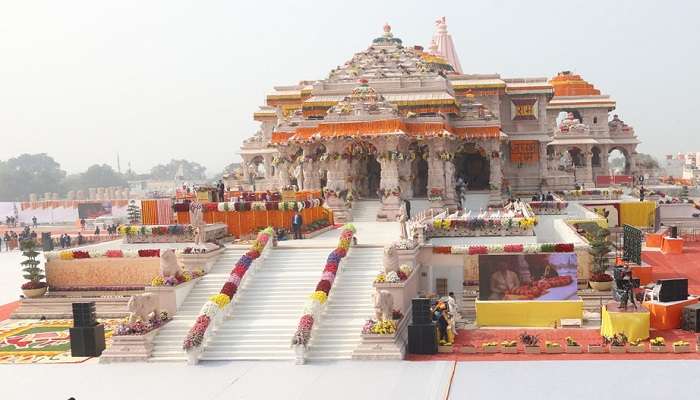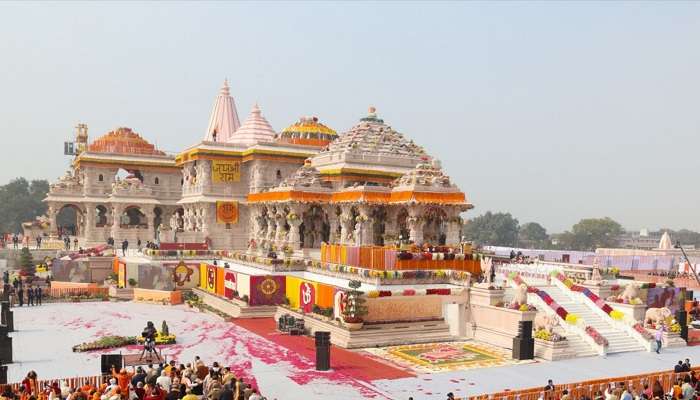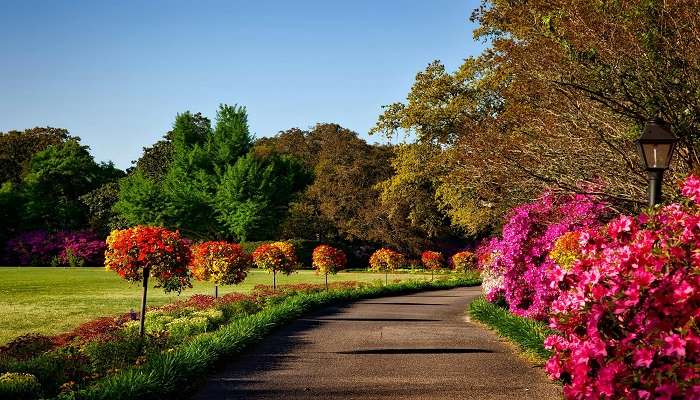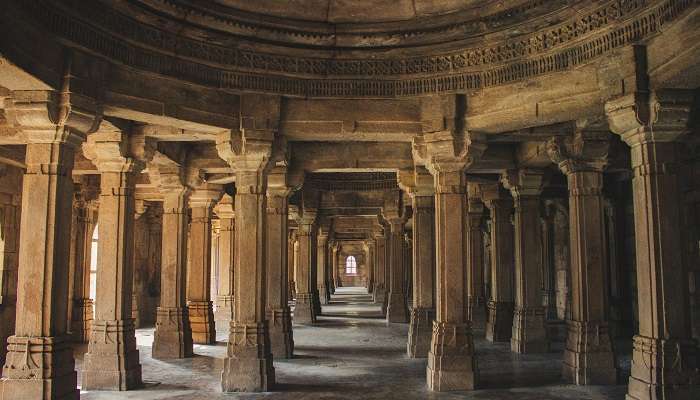Discover The Sacred Shree Ram Janmbhoomi In Ayodhya On Your Trip In 2026

Shri Ram Janmabhoomi ( ’Birthplace of Rama’) is the site that, according to Hindu religious beliefs, is the birthplace of Rama, the seventh avatar of the Hindu deity Vishnu. The Shri Ram Janmabhoomi Teerth Kshetra Trust began the first phase of construction of the Ram Mandir in March 2020. Prime Minister Narendra Modi performed Bhoomi Pujan and laid the foundation stone of the Ram Temple in Ayodhya on 5 August 2020. The Ramayana states that the location of Rama’s birthplace is on the banks of the Sarayu River in a city named “Ayodhya”. Shree Ram Janmbhoomi is an essential place for those seeking a spiritual experience.
About Shree Ram Janmbhoomi

Ram Janmabhoomi (lit. ’Birthplace of Rama’) is the site that, according to Hindu religious beliefs, is the birthplace of Rama, the seventh avatar of the Hindu deity Vishnu. The Ramayana states that Rama’s birthplace is on the banks of the Sarayu River in a city called Ayodhya. Modern-day Ayodhya is in the north Indian state of Uttar Pradesh. Whether the Ayodhya mentioned in the Ramayana is the same as the modern city is contested.
The Ramayana, a Hindu epic whose earliest portions date back to the 1st millennium BCE, states that Rama’s capital was “Ayodhya,” which may not be the same as modern Ayodhya. The Shri Ram Janmabhoomi Teerth Kshetra Trust began the first phase of construction of the Ram Mandir in March 2020. Prime Minister Narendra Modi performed Bhoomi Pujan and laid the foundation stone of the Ram Temple in Ayodhya on 5 August 2020.
Also Read: Picnic Spots In Lucknow
Things To Do At Shree Ram Janmbhoomi
There are various things to indulge in while in Shree Ram Janambhoomi in Ayodhya, as mentioned below.
1. Visit The Ram Mandir

The Ram Mandir is a partially constructed Hindu temple complex in Ayodhya, Uttar Pradesh, India. Many Hindus believe that it is located at the site of Ram Janmabhoomi, the mythical birthplace of Rama, a principal deity of Hinduism. The original design for Ram Mandir was devised in 1988 by the Sompura family of Ahmedabad. The Sompuras have contributed to the design of over 100 temples worldwide for at least 15 generations, including the Somnath temple. The chief architect of the temple was Chandrakant Sompura, assisted by his two sons, Nikhil Sompura and Ashish Sompura, who are also architects.
Timing: Open from 6:00 AM to 12:00 PM and 4:00 PM to 9:00 PM.
Exact Location: Ramkot, Ayodhya, Uttar Pradesh, India.
Nearest Airport: Ayodhya Airport (Approx. 10 km away).
Nearest Railway Station: Ayodhya Junction (Approx. 3 km away).
2. Explore The Hanuman Garhi

Hanuman Garhi is a Hindu temple of Hanuman in Uttar Pradesh, India. Located in Ayodhya, it is one of the most important temples in the city, along with other temples such as Ram Mandir and Nageshwar Nath. Hanuman Garhi Temple is shaped like a four-sided fort with circular ramparts at each corner, housing shrines dedicated to the primary deity Hanuman. There are 76 stairs to reach the main temple, where the garbha griha, adorned with silver carvings, awaits. The centre has three intricately designed doors leading to the inner chamber. Within, a 6-inch deity of Hanuman, depicted in his youthful (Bal) form, is positioned on the lap of his mother, Anjani.
Timing: Open from 5:00 AM to 10:00 PM.
Exact Location: Hanuman Garhi, Ayodhya, Uttar Pradesh, India.
Nearest Airport: Ayodhya Airport (Approx. 10 km away).
Nearest Railway Station: Ayodhya Junction (Approx. 2.5 km away).
Related Post: Places To Visit In Uttar Pradesh
3. Stroll Along The Saryu River

Ram Ki Paidi is a set of sacred ghats on the banks of the Sarayu River in the holy city of Ayodhya, Uttar Pradesh, India. There are thirty-two bathing ghats at Ram Ki Paidi, where devotees can take a sacred bath. Devotees gather here to take a holy wash, believing they will be cleansed of their sins. Take a peaceful walk along the banks of the Saryu River, a site of great religious significance. Many devotees take a holy dip in its waters, believing it to cleanse sins. On the bank of the river Sarayu lies the sacred city of Ayodhya, which has deep mythological and religious roots. The river is also mentioned in the ancient scripts of the Rigveda and the Atharvaveda.
Best Time to Visit*: Early morning or sunset for the best views.
Exact Location*: Saryu Ghat, Ayodhya, Uttar Pradesh, India.
Nearest Airport*: Ayodhya Airport (Approx. 11 km away).
Nearest Railway Station*: Ayodhya Junction (Approx. 4 km away).
4. Explore Ram Katha Park

Ram Katha Park is a beautiful park in Ayodhya that houses open-air theatres and well-kept lawns. Spread over a vast area, it is a popular venue for devotional programmes, cultural performances, religious events, dance, poetry and katha recital sessions. The park provides a tranquil setting for relaxation and contemplation amidst nature. Ram Katha Park was established to relieve the pressure on these holy sites and the city. The park is a tranquil retreat where people of all ages can immerse themselves in a spiritually charged setting. Ram Katha Park offers a variety of family-friendly activities for guests of all ages. From devotional activities to cultural performances, there is something for everyone. The park’s open-air theatres offer a venue for local and visiting artists to demonstrate their skills in theatrical performances, dance, music, and poetry.
Timing: Open from 8:00 AM to 7:00 PM.
Exact Location*: Near Naya Ghat, Ayodhya, Uttar Pradesh, India.
Nearest Airport*: Ayodhya Airport (Approx. 11 km away).
Nearest Railway Station*: Ayodhya Junction (Approx. 4 km away).
Related Post: Hotels In Ayodhya
5. Visit Kanak Bhawan

Kanak Bhawan is one of the finest and most famous temples in Ayodhya and is a must-visit. It is believed that this Bhawan was gifted to Devi Sita by Kaikei immediately after her marriage to Lord Ram. This is the private palace of Devi Sita and Lord Rama. Vikramaditya got it renovated. Kanak Bhawan is another important Ayodhya temple dedicated to Lord Ram and Goddess Sita. The temple is known for its beautiful idols adorned with gold ornaments. Explore the temple and appreciate its historical and religious significance. Ayodhya’s Kanak Bhawan’s façade is a testament to faith and reverence, inspiring devotion. Inside Kanak Bhawan, devotees offer prayers to Lord Ram and Goddess Sita amidst divine surroundings. Kanak Bhawan’s exterior shines with golden hues, symbolising luxury and devotion.
Timing: Open from 7:00 AM to 12:00 PM and 4:00 PM to 9:00 PM.
Exact Location: Kanak Bhawan, Ramkot, Ayodhya, Uttar Pradesh, India.
Nearest Airport*: Ayodhya Airport (Approx. 10 km away).
Nearest Railway Station*: Ayodhya Junction (Approx. 3 km away).
6. Nageshwarnath Temple

The temple of Nageshwarnath is said to have been established by Kush, the son of Rama. Legend is that Kush lost his armlet while bathing in the Saryu, which was picked up by a Nag-Kanya, who fell in love with him. As she was a devotee of Shiva, Kush erected this temple for her. Nageshwarnath Temple is one of the oldest temples in Ayodhya and is dedicated to Lord Shiva. According to legend, it was established by Kush, the son of Lord Ram. The temple is an important pilgrimage site, especially during the festival of Mahashivratri. The present temple was built in 1750 by the Safdar Jung minister Naval Rai. The festival of Shivratri is celebrated here in a big way, and the Shiv Barat procession is particularly significant during these celebrations. During the festival of Mahashivratri, the temple receives thousands of devotees.
Timing: Open from 5:00 AM to 8:00 PM.
Exact Location: Ram Ki Paidi, Ayodhya, Uttar Pradesh, India.
Nearest Airport: Ayodhya Airport (Approx. 11 km away).
Nearest Railway Station: Ayodhya Junction (Approx. 3.5 km away).
Related Post: Hanuman Bagh
7. Mani Parvat

According to Ramayana, Lord Hanuman uprooted an entire mountain containing the rejuvenating Sanjeevani Booti to treat Lakshman, who was wounded in a battle by Meghnath. It is believed that a part of the mountain fell at a place in Ayodhya called Mani Parbat. It lies close to another mound called Sugriv Parbat. Mani Parvat in Ayodhya is at a height of 65ft. It is believed to be a part of the hill of Sanjeevani Booti that lord Hanuman carried. The mountain offers a great view of Ayodhya and is a peaceful place for meditation and relaxation.
Timing: Open from 5:00 AM to 7:00 PM.
Exact Location: Mani Parvat, Ayodhya, Uttar Pradesh, India.
Nearest Airport: Ayodhya Airport (Approx. 12 km away).
Nearest Railway Station: Ayodhya Junction (Approx. 5 km away).
8. Chakravarti Mahraj Dashrath Mahal

It is believed that this is where Maharaj Dashrath lived. Now, a temple is inside of Ram, Sita, Lakshmana, Bharat, and Shatrughan. This place is also known as Bada Sthan or Badi Jagah. The palace is an important historical site and is revered by devotees. It features beautiful architecture and is a place of worship. Dashrath Mahal in Ayodhya is an extraordinary location to visit. Its distance from Hanuman Garhi is 50 metres. This place is located in the centre of Ayodhya city.
Timing: Open from 6:00 AM to 10:00 PM.
Exact Location: Near Ramkot, Ayodhya, Uttar Pradesh, India.
Nearest Airport: Ayodhya Airport (Approx. 10 km away).
Nearest Railway Station: Ayodhya Junction (Approx. 3 km away)
You May Also Like To Read: Places To Visit In Lucknow
Get ready for an unforgettable experience in Ayodhya! Ensure you schedule visits to the city’s iconic attractions. Don’t miss the opportunity to explore the sacred Shree Ram Janmbhoomi, a revered pilgrimage site. Book your trip to Ayodhya in advance to avoid last-minute hassles. With careful planning, you’ll create lifelong memories in this ancient city.
For our editorial codes of conduct and copyright disclaimer, please click here.
Cover Image Credit: रूही for wikimedia commons
Frequently Asked Questions About Shri Ram Janmabhoomi
Where is the location of Shree Ram Janmbhoomi?
Located in the northern Indian state of Uttar Pradesh, the city of Ayodhya is home to Shree Ram Janmbhoomi.
Which time of year is ideal for visiting Shree Ram Janmbhoomi?
Visits to Shree Ram Janmbhoomi are most enjoyable in the cooler months of October through March. Travelling on significant Hindu holidays, such as Ram Navami, can also be a fulfilling spiritual experience.
Are there any nearby attractions to visit?
Certainly, there are several neighbouring sites, such as the banks of the Saryu River, Hanuman Garhi, Kanak Bhawan, and Nageshwarnath Temple. Extra spiritual and historical insights can be gained from these sites.
When visiting Shree Ram Janmbhoomi, what should I wear?
It is recommended that guests dress properly and modestly, covering their knees and shoulders. It is advised to dress in traditional Indian garb, particularly when taking part in events and rituals.
What are the local delicacies to try in Ayodhya?
Ayodhya offers a variety of North Indian delicacies. Local sweets like peda are popular, and traditional vegetarian dishes are widely available in nearby eateries.
People Also Read:
Places to Visit in Uttar Pradesh Hill Stations Near Uttar Pradesh Kalinjar Fort In Uttar Pradesh

Unveil the hidden treasures of the globe and turn every travel dream into reality. As a Content Writer, I am passionate enough to craft stories from ancient wonders to modern marvels. My words paint the picture-perfect itinerary for unforgettable experiences. Let my words be your trusted guide to immerse in the diverse culture and discover the beauty of the unknown.











